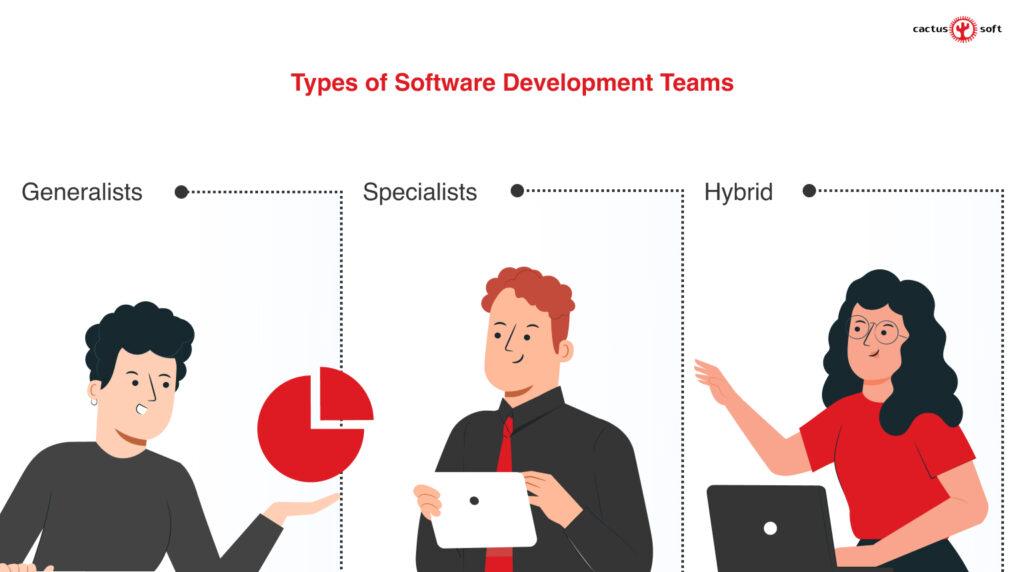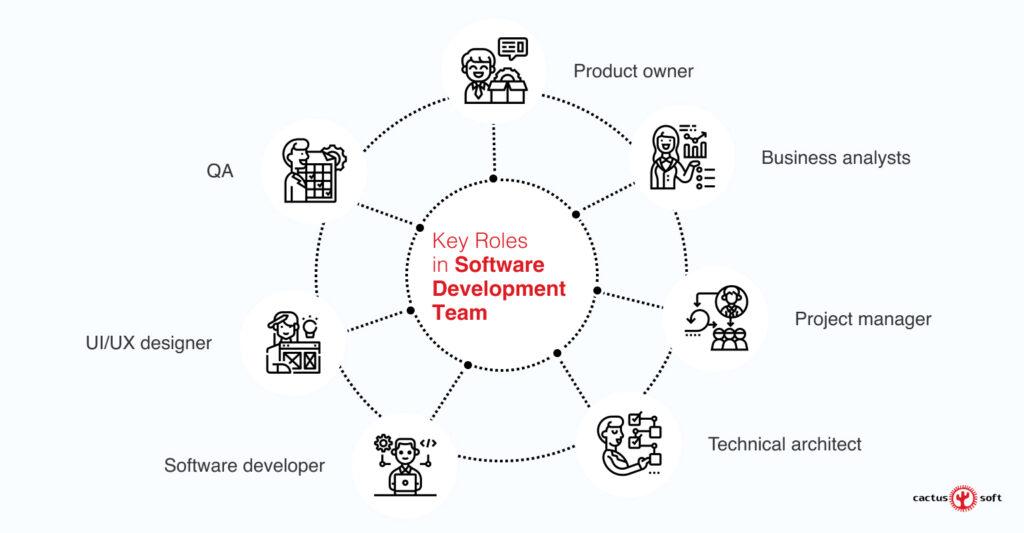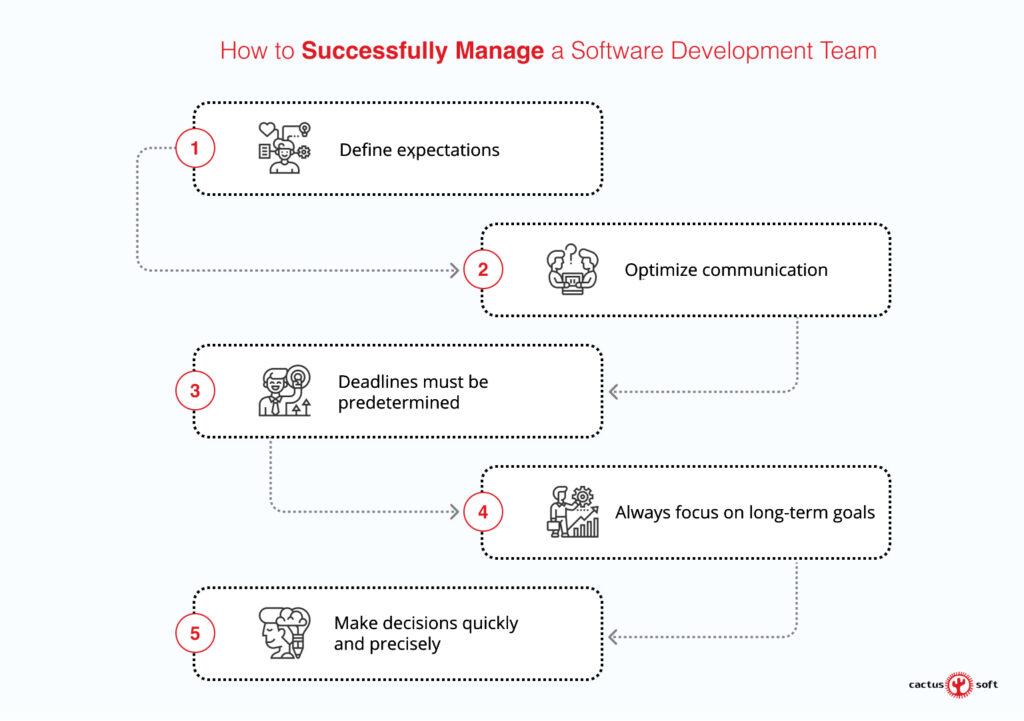You must be wondering why everyone is rushing around trying to build their own software development team. What exactly does it bring to the table? Anyone who is unaware of the term might consider this some kind of black magic, consisting of a plethora of strange words and terminologies. In fact, there are often several non-techies who sink in the midst of the software development sea, especially while conducting their first project.
With the world evangelizing about which are the best apps, businesses are compelled to jump onto the development bandwagon – and their competitors are surely doing the same thing. Here’s the thing: once you start understanding what software development is all about, the next challenge is deciding how to structure a software development team. Most people find themselves in a dilemma at this point. The following post focuses on how to carry out this venture so that it catapults your business to success.

Software Development Life Cycle
A software development life cycle is based on flexibility, transparency, and high-end productivity.
Why choose a software development approach? When you are bound to receive a plethora of advantages such as high-end quality, lower risks, cost-effective solutions, faster delivery, and a competitive edge, why not? Surviving in the present changeable market has become next to impossible. It’s more like solving a jenga puzzle: one wrong move can destroy the entire build-up.
Before we move onto how to structure a software development team, let us explore the different types of software development teams you must consider. Now many of you may wonder why not consider an individual programmer or a freelancer instead of hiring or building an entire software development team. One of the obvious reasons is that one person cannot perform all the tasks that an entire team can accomplish in much less time.
Apart from that, every individual has some limitations or saturation points, which might sooner or later become a huge bottleneck for your upcoming projects. On the other hand, if you have a team, every individual can motivate others so they can push themselves together.
Lastly, it is not necessary that every member of your software development team is equally experienced, but that’s the beauty of it. Each team member has a unique set of skills and experience that eventually enables them to become a great team of problem solvers when working together.

Types of Software Development Teams
Let us dig into the details, starting with the types of software development teams.
#1 Generalists – You must have heard of someone being a jack of all trades. This kind of software development team is the same: they know something about everything. And it’s not just limited to knowledge. They do carry experience up to a certain point. As the name implies, such teams are usually asked to handle basic projects, which also means they tend to lack the skills needed in areas requiring a high level of expertise.
#2 Specialists – The next option we have is the specialists. As the name suggests, specialists know a particular field inside out. They are extremely knowledgeable and experienced in specific areas, although the team members may lack the overall general understanding and skills required for different roles and responsibilities.
#3 Hybrid – This type of team is a mix of the aforementioned ones. The hybrid approach kills two birds with one arrow, as it includes both specialists and generalists. While the specialists can focus on their own particular forte, the generalists are responsible for everything else. If you are hoping to create a dream team, look no further than this option.

How to Structure a Software Development Team
By now, you must be convinced of the importance of building a software development team. You can hire several experts on an individual basis who aren’t just skilled but are also experienced, and you can consider all the latest trends, but all this is pure waste if there’s no structure to your team.
Key Roles in a Software Development Team
#1 Product Owner – As the name implies, the product owner is the one who supervises everything from start to finish. The product owner works internally as well as externally.
#2 Business Analysts – A business analyst compiles a list of needs and requirements and conveys them to the team members. Every piece of information – small or large – is shared in regard to what features and functionality the software product must include.
#3 Project Manager – Another leadership role in your software development team is the project manager. The product manager plans, monitors, and delivers the project on time. They determine the overall goals for the team and ensure everyone has the required administrative and technical support to do their job efficiently.
#4 Technical Architect – Another professional is the technical architect. They design the entire system, including workflow and database diagrams. Here, the professional draws up a system blueprint and assesses the interaction of different modules. This expert also chooses the technology stack to suit the technical and non-technical requirements of the software and provides guidance on complex issues.
#5 Software Developer – We all know what a software developer is. These professionals are skilled in programming languages, frameworks, databases, APIs, and so much more.
#6 UI/UX Designer – UI and UX designers are responsible for making the software visually attractive and intuitive to use.
#7 QA – Of course, any software development project contains bugs and errors. They are inevitable, no matter how hard you try to avoid them. So here you need a QA analyst who considers performance-related issues and gives feedback to the developers.

How to Successfully Manage a Software Development Team
Below are a few tips and tricks to keep in mind when managing a software development team.
#1 Define Expectations
It is very important to map out all your needs and requirements before structuring a software development team. So even once you have structured a development team, it is still crucial to define the scope of the development team to deliver high-end software.
Capturing requirements precisely right from the beginning and documenting them can ensure the software developers, project manager, UI/UX designer, and the entire team remain on the same page and know exactly what to work on.
#2 Optimize Communication
Today, outsourcing and offshore software development have become pretty much in vogue, all thanks to the neverending COVID-19 pandemic. Now when working with an offshore development company – or even if you have built your own offshore development team – communication issues are inevitable. So make sure you have that rapport, as effective communication is very important. Fortunately, there are a plethora of communication tools available, such as Skype, FaceTime, and emails.

#3 Deadlines Must Be Predetermined
This is pretty obvious, but businesses often ignore such factors, especially when working with a software development team. When things don’t work according to the predefined deadlines, you may end up with additional costs. Also, missed deadlines often put you and your teammates at unseen and unavoidable risk. Put simply, it is crucial to set manageable deadlines at the beginning and ensure that your software development team sticks to them.
Fortunately, now we have so many tools and technologies available, different tasks can be easily prioritized. Unlike previously, businesses can now keep seamless track of different projects simultaneously.
#4 Always Focus on Long-Term Goals
There are times when your software development team might slow down or become stagnant. When productivity gets low, you don’t have to barge in and hammer on their hands. Sometimes it’s better if you take a setback. All you have to do is focus on the long-term goals, instead of day-to-day tasks.
Developers often get stuck on a problem and can waste time pondering over it. Having multiple tasks in the pipeline can help them focus on the next one and come back to the issue another time.
#5 Decision Making
Try creating a software development team that can make decisions as quickly and as precisely as possible. Managers often lose out in providing value when they are involved in every decision-making process. Also, developers often lose productivity when they have to keep seeking permission from their seniors. How nice would it be if they could make a call on their own? So try this: trust your team, and encourage them to take the call and make responsible decisions independently.
The more decisions your team makes on its own, the fewer choices you need to make. In this way, freeing up your time also gives your team autonomy. Things will happen faster, which is better for everyone.

Conclusion
All in all, it’s about making the right choice and creating a software development team in the best possible way. Creating a software development team doesn’t mean you are done with things, though. This is just the beginning! After this, it’s your duty to balance roles and responsibilities precisely. For example, only listening to the product owner can cost you a lot, as the software developed might not be able to win the hearts of potential users.
A project manager may, for instance, overlook the need for a DevOps engineer, thus preventing themselves from tapping into numerous benefits. Overall, to ensure the right proportion of expertise and new perspectives, you can always seek assistance from a reliable development company.








